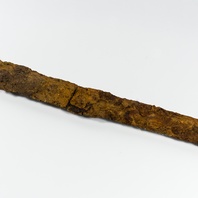
Viking Objects
Sword (1989-59/7113)
This Viking Age sword was found in Grave 511 at Repton where the invading Viking Great Army had their winter camp in 873/4. When it was found, the sword had traces of a wooden scabbard attached to the rusted blade. Analysis showed that the scabbard was lined with fleece and covered in leather. The grip was wooden and covered in a woollen textile.
Read More
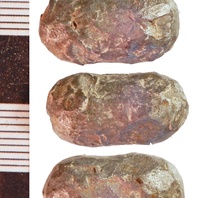
Viking Objects
Silver Ingot (NLM-ABB952)
This silver ingot was made by melting down worked silver and casting it in a mould. The Vikings arriving in England had a bullion economy in which they paid for goods with silver that was weighed to an amount agreed between the buyer and the seller. Hacksilver and silver ingots are the most common evidence for their bullion economy. It took some time for the Scandinavian settlers to adopt a monetary economy like that of the Anglo-Saxons, and both systems were used simultaneously for a while before they fully adopted the new system. The Vikings were familiar with monetary economies but they treated coins as just another form of silver before adoption of a monetary economy.
Read More
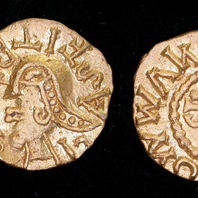
Viking Objects
Merovingian Tremissis (LEIC-6BAA60)
This Merovingian gold tremissis was minted in Bourges in the late 6th or 7th century. It is possible that it made its way to England prior to Viking incursions but it is equally likely that the Vikings brought this coin with them as plunder after raiding in Frankia.
Read More
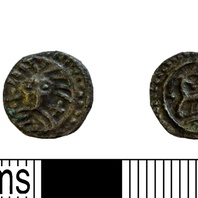
Viking Objects
Danish Silver Sceat (NARC-70AFF4)
This silver sceat is classified as part of the Danish Series X Type 31. The obverse depicts the head of Woden with crosses to either side of a rounded beard and pellet above. The reverse depicts a monster facing left. These coins are considered to be associated with the early trading center at Ribe. It is very likely that they made their way to England by means of Vikings.
Read More
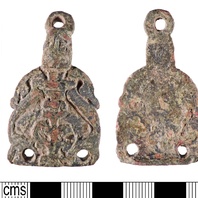
Viking Objects
Stirrup-Strap Mount (LIN-D274D5)
This Anglo-Scandinavian cast copper-alloy stirrup-strap mount is decorated with zoomorphic ornamentation. It has been classified as a William Class A Type 6 mount.
Read More
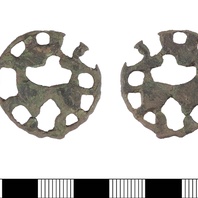
Viking Objects
Urnes-Style Mount (LIN-FA6943)
This copper-alloy mount features Urnes-style openwork decoration.
Read More
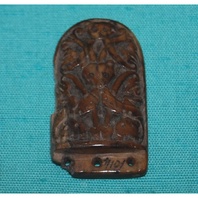
Viking Objects
Belt Terminal (L.A67.1864.3.0)
A belt terminal in an Anglo-Scandinavian zoomorphic style that was found in Leicester. It features two opposed ‘lions’, two central masks and acanthus scrolls. Strap ends or belt terminals came in various styles and were fairly common throughout the Viking world. They were used to decorate the ends of belts and to stop them getting damaged.
Read More
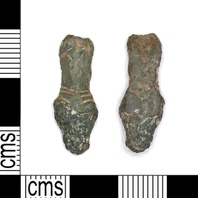
Viking Objects
Anglo-Scandinavian Strap-End (LEIC-1DD0CD)
This copper-alloy strap-end fragment is decorated in an Anglo-Scandinavian style consisting of a triangular cross-sectioned shaft which terminates in a triangular-shaped animal head. It is classed as a Thomas Class B, Type 4 strap-end which were introduced during the later eighth or early ninth century and remained popular into the eleventh century.
Read More
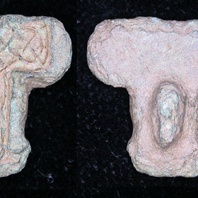
Viking Objects
Irish Gilded Mount (LEIC-09D1C8)
This fragment of a gilded copper-alloy mount is roughly T-shaped, and has a raised border around a panel of chip-carved interlace which has traces of gilding. It is possible that it made its way to England prior to Viking incursions but it is equally likely that the Vikings brought this brooch with them as plunder after raiding various areas in Ireland.
Read More
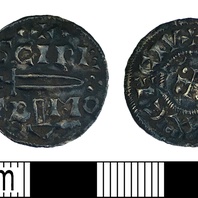
Viking Objects
Silver Viking Penny (DENO-FCA770)
This is a silver penny of a type know as the St Peter Sword/Cross type which bears an inscription to St Peter of York (c. 905-927) and was minted at York between 921 and 927. Viking rulers in the Danelaw eventually took up the Anglo-Saxon practice of minting coins which helped legitimise their authority.
Read More
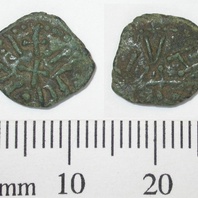
Viking Objects
Northumbrian Styca (DENO-EF4544)
The blundered legends on this example suggest it is an imitation of stycas minted for a Northumbrian ruler or the Archbishops of York. While Wessex and Mercia were using silver coinage as part of their monetary economy, Northumbria was using copper coins known as stycas, which may have contained trace amounts of silver. The concentration of these coins at sites such as Torksey and ARSNY suggests that they could have remained in circulation after the fall of Northumbria in 866 but were taken to the sites by the Vikings during their campaigning. They were not much use to the Vikings within their silver-based bullion economy but it is suggested that they were treated as raw material and were used as commodity money instead. The evidence for the production of copper-alloy strap-ends at Torksey and ARSNY supports this idea that the stycas were used for production.
